
Feature Archive |
November, 2001
Tragedy and Triumph at Arles:
Van Gogh and Gauguin
| By Joseph Phelan |
Van Gogh and Gauguin: The Studio of the South at the Art Institute of Chicago centers on the intimate friendship between the two troubled Titians of modern art.
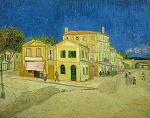 Readers of Irving Stone's novel Lust for Life or viewers of the Vincente Minnelli movie version (with the young Kirk Douglas and Anthony Quinn) are unlikely to ever forget the intensely dramatic and nearly fatal relationship which ended on a Christmas Eve when a frenzied Van Gogh threatened Gauguin with a straight razor and then mutilated part of his own ear. Few men have struggled so manfully with their demons or suffered so much for their art.
Readers of Irving Stone's novel Lust for Life or viewers of the Vincente Minnelli movie version (with the young Kirk Douglas and Anthony Quinn) are unlikely to ever forget the intensely dramatic and nearly fatal relationship which ended on a Christmas Eve when a frenzied Van Gogh threatened Gauguin with a straight razor and then mutilated part of his own ear. Few men have struggled so manfully with their demons or suffered so much for their art.Few artists have ever seen life so intensely or realized their vision in such splendid fullness. Despite our familiarity with the work of these pioneers, until now it was impossible to actually see and enjoy in one show the harvest of this encounter. This definitive exhibit offers a week-by-week, and at times even a day-by-day chronicle of their artistic dialogue during the nine autumn weeks of 1888 when Paul Gauguin moved into the Yellow House [right] in Arles.
Vincent van Gogh in 1880 was a 27-year-old failure: a despised and rejected clergyman in a grim backwater mining town in Belgium. Against all the odds he decided to become a serious painter. By 1886, Vincent thought he was good enough to move to Paris to live with his brother Theo, an art dealer specializing in Impressionist painters. With Theo's help, Vincent found a little group of fellow spirits including Toulouse-Lautrec and Emile Bernard, and organized a show of their work in a downscale café. The Painters of the Petit Boulevard (so-called to distinguish them from the painters of the grand boulevard - i.e. the Impressionists) attracted Paul Gauguin - a much more successful painter who had already exhibited with the Impressionists.
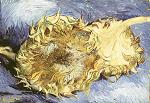 Gauguin was struck by one painting in the exhibit. Van Gogh's Two Sunflowers [left], a monumental pair of buds ready to burst forth, look more like firecrackers than mere flowers; none of the Impressionist had ever thought to paint humble natural things in such an awesome and incendiary manner. This was the beginning of Vincent's many études from nature, of oleanders, irises and roses, peach and cypress trees and rolling wheat fields; of things he loved both for their natural beauty and their symbolic significance.
Gauguin was struck by one painting in the exhibit. Van Gogh's Two Sunflowers [left], a monumental pair of buds ready to burst forth, look more like firecrackers than mere flowers; none of the Impressionist had ever thought to paint humble natural things in such an awesome and incendiary manner. This was the beginning of Vincent's many études from nature, of oleanders, irises and roses, peach and cypress trees and rolling wheat fields; of things he loved both for their natural beauty and their symbolic significance.Gauguin coveted this painting, offering in exchange his best work to date: By the Shore of the Lake, painted in Martinique. These men were drawn together for two reasons: first, by their urgency to find new ways to express their visions; then by their uncertain status as aging newcomers struggling in the highly competitive impressionist art market. Two lost souls on the highway of life; such people sometimes find a new path to Parnassus.
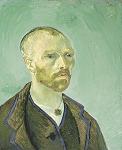 Paris was unbearable. Gauguin despaired at what he saw around him - egotism, luxury and domination by the rich, and the way his fellow artists all too slavishly catered to it. In Brittany, he hoped to find a society closer to the primitive and uncorrupted conditions of human happiness recommended by the philosopher Jean-Jacques Rousseau, by whom Gauguin was influenced. Vincent, on the other hand, badly needed to purge the fogs and ghosts of the Protestant North from his blood; he headed for the ancient Roman city of Arles to dry out.
Paris was unbearable. Gauguin despaired at what he saw around him - egotism, luxury and domination by the rich, and the way his fellow artists all too slavishly catered to it. In Brittany, he hoped to find a society closer to the primitive and uncorrupted conditions of human happiness recommended by the philosopher Jean-Jacques Rousseau, by whom Gauguin was influenced. Vincent, on the other hand, badly needed to purge the fogs and ghosts of the Protestant North from his blood; he headed for the ancient Roman city of Arles to dry out.At the farthest ends of the nation, isolated and misunderstood by almost everyone around them, Paul and Vincent sustain and inspirit each other to produce breakthrough works. At first they exchanged self-portraits, larger than life, of almost frightening power and depth, showing how they saw themselves and how they wished to be seen. Vincent, trying to look like a Buddhist monk [right] with his shaved head and severe expression, only reaffirmed the lack of Nirvana in his life. Gauguin with his "savage" Inca profile and fiery complexion, entitled his portrait Les Misérables [below left], after Hugo's novel; he is the "alleged terrorist", the good man misunderstood by respectable society.
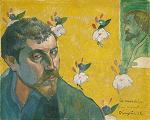 In preparation for that fall, Vincent painted more Sunflowers [below right]. In the exhibition, these legendary treasures (destined to become the most expensive art works in the world) can now be seen in their rightful place as the welcoming decorations for Gauguin's bedroom in Arles.
In preparation for that fall, Vincent painted more Sunflowers [below right]. In the exhibition, these legendary treasures (destined to become the most expensive art works in the world) can now be seen in their rightful place as the welcoming decorations for Gauguin's bedroom in Arles.When Gauguin arrived, Vincent insisted they work his way: from nature out of doors. Gauguin resisted, hoping to convince Vincent to paint from the imagination; they tried both, leaving the indoor painting for rainy days. The culminating painting here is an indoor one: Gauguin's Van Gogh Painting Sunflowers, which Vincent described as "me, of course, but Mad."
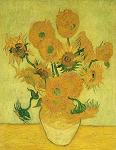 Then towards Christmas, Vincent's mind snapped: he argued with Gauguin, threw a drink of at him in a bar, the next day stalked him with a straight razor, then hacked part of his own ear lobe off and collapsed.
Then towards Christmas, Vincent's mind snapped: he argued with Gauguin, threw a drink of at him in a bar, the next day stalked him with a straight razor, then hacked part of his own ear lobe off and collapsed.A few days later, as the New Year began, he was writing to Gauguin and Theo telling them they had made a fuss over something of no great importance. Yet his terrified neighbors insisted that Van Gogh be transferred to a mental hospital in another town. He was to spend long months in the asylum in San Remy, producing some of his greatest works. Gauguin was happy to continue the friendship at a safe distance.
In 1890, Vincent committed suicide and Theo died six months later, heartbroken and wrecked. Gauguin, although more outwardly attractive and successful, ended up spending the next fifteen years searching for an imaginary lost paradise in Tahiti - syphilitic, broke and ultimately alone. Yet he continued to write with special affection of the two brothers who were his friends and of his appreciation of Vincent's genius.
If you cannot see the exhibit in person you can spend a wonderful time working your way through the exhibit catalogue with its reconstructed maps and photos of all the places they painted. Both the Art Institute of Chicago and the Van Gogh Museum have excellent websites. Most comprehensive of all is the Vincent van Gogh Information Gallery, which has all of Vincent's paintings, sketches and letters online.
Related Links:
- Van Gogh and Gauguin: The Studio of the South
Art Institute of Chicago: until January 13, 2002
Van Gogh Museum, Amsterdam: February 9 through June 2, 2002
- Artcyclopedia Artist Pages:
Vincent van Gogh
Paul Gauguin
- Vincent van Gogh Information Gallery
This article is copyright 2001 by Joseph Phelan. Please do not republish any portion of this article without written permission.
Joseph Phelan can be contacted at joe.phelan@verizon.net
Past Articles
October, 2001
Her Last Bow: Sister Wendy in America, by Joseph Phelan
September, 2001
Love, Death and Resurrection: The Paintings of Stanley Spencer, by Joseph Phelan
August, 2001
Who is Rodin's Thinker?, by Joseph Phelan
July, 2001
Celebrations North and South, by Joseph Phelan
June, 2001
Rubens and his Age, by Joseph Phelan
May, 2001
Great Reproductions of Great Paintings
April, 2001
The Passion of Christ, by Joseph Phelan
March, 2001
Edouard Manet: Public Spaces, Private Dreams, by Joseph Phelan
February, 2001
Henry Moore and the British Museum: The Great Conversation, by Joseph Phelan
December, 2000
Advent Calendar 2000, narrated by Joseph Phelan
November, 2000
Article: Notorious Portraits, Part II, by John Malyon
October, 2000
Article: Notorious Portraits, Part I, by John Malyon
Article: The Other Michelangelo, by Joseph Phelan
September, 2000
Article: The Art of Drawing, by Joseph Phelan
August, 2000
Article: Poussin and the Heroic Landscape, by Joseph Phelan
July, 2000
Article: Great Art Museums Online, by Joseph Phelan
June, 2000
Article: Venetian Painting and the Rise of Landscape, by Joseph Phelan
May, 2000
Article: Forbidden Visions: Mythology in Art, by Joseph Phelan
April, 2000
Article: Themes in Art: The Passion of Christ, by Joseph Phelan
Web site review: Christus Rex
March, 2000
Web site review: National Gallery of Art, Washington, D.C., by Joseph Phelan
Online exhibit review: Inuit Art: The World Around Me, by John Malyon
February, 2000/Poll: Who is Producing the Most Interesting Art Today? (Results)
January, 2000/Poll: Who is Producing the Most Interesting Art Today? (Part II)
December, 1999/Poll: Who is Producing the Most Interesting Art Today? (Part I)
November, 1999/The Louvre Museum
Web site review: The Louvre
October, 1999/Impressionism
Web site review: North Carolina Museum of Art
September, 1999/Optical Art
Web site review: The Butler Institute of American Art
August, 1999/Animals in Art
Web site review: National Museum of Wildlife Art
Online exhibit review: PBS: American Visions
July, 1999/Surrealism
June, 1999/Sculpture
Web site review: Carol Gerten's Fine Art
Online exhibit review: Michael Lucero: Sculpture 1976-1995
May, 1999/Women in the Arts
Web site review: National Museum of Women in the Arts
Online exhibit review: Jenny Holzer: Please Change Beliefs
April, 1999/The Golden Age of Illustration
Web site review: Fine Arts Museums Of San Francisco
Online exhibit review: Treasure Island and Robinson Crusoe online
March, 1999/Vincent van Gogh
Web site review: Van Gogh Museum, Amsterdam
Web site review: The Vincent van Gogh Information Gallery
February, 1999/Great Art
Web site review: The State Hermitage Museum, St. Petersburg, Russia
Online exhibit review: John Singleton Copley: Watson and the Shark